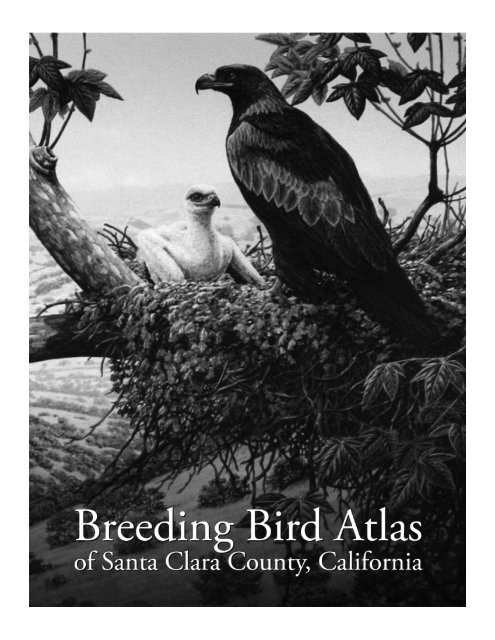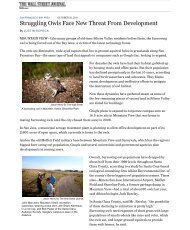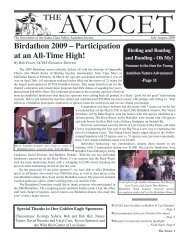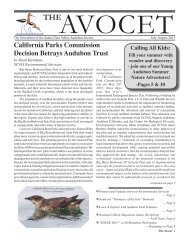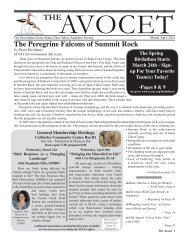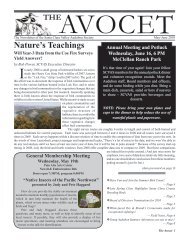Chestnut-backed Chickadee - Santa Clara Valley Audubon Society
Chestnut-backed Chickadee - Santa Clara Valley Audubon Society
Chestnut-backed Chickadee - Santa Clara Valley Audubon Society
You also want an ePaper? Increase the reach of your titles
YUMPU automatically turns print PDFs into web optimized ePapers that Google loves.
SPECIES ACCOUNTS<strong>Chestnut</strong>-<strong>backed</strong> <strong>Chickadee</strong>Poecile rufescensThis active, agile parid with its quiet “see-see-see” has undergonea range expansion in the last century throughout westernNorth America, including <strong>Santa</strong> <strong>Clara</strong> County. Generally foundwithin 80 km of the coast from southeast Alaska to central California,it is also established well inland in Washington, Idaho,and British Columbia, and in recent decades has expanded intothe Sierra Nevada of California as far south as Madera County.Three subspecies are recognized, and the southernmost, P. r. barlowi,is the one that resides in <strong>Santa</strong> <strong>Clara</strong> County. The rangeof barlowi extends from San Francisco and Oakland south tocoastal <strong>Santa</strong> Barbara County (Garrett and Dunn 1981). Thetype specimen of P. r. barlowi was a male collected by JosephGrinnell along Stevens Creek in <strong>Santa</strong> <strong>Clara</strong> County in October1900 (Grinnell 1900a). Today, the <strong>Chestnut</strong>-<strong>backed</strong> <strong>Chickadee</strong>is a common resident in the western portions of <strong>Santa</strong> <strong>Clara</strong>County wherever there are coniferous or broadleaved evergreenforests or woodlands. It is also fairly common in lowland areaswith healthy riparian corridors, as well as in urban habitats withplanted conifers and other suitable evergreen trees.Van Denburgh (1899b) considered this species commonnear Saratoga, but less so in Los Gatos. Grinnell (1915), in hissecond distributional list of California birds, noted that the subspeciesbarlowi bred along the coast from San Francisco to theLittle Sur River in Monterey County, and placed its easternmostextension on the west shore of the San Francisco Bay near themouth of San Francisquito Creek. Grinnell and Wythe (1927)considered this distribution little changed at the time of their SanFrancisco Bay regional survey, and Grinnell and Miller (1944)repeated the earlier range descriptions but also noted breeding inthe vicinity of San Jose. By the late 1940s it was apparent thatthis species was moving into the Berkeley Hills, and this findingled to a series of papers that examined both the range expansionof this chickadee and its ecological interactions with theestablished parid, the Oak Titmouse (Dixon 1954, Dixon 1960,Root 1964, Hertz et al. 1976). Dixon (1954) tracked the rangeexpansion to Sunol in Alameda County as early as the late 1930sand speculated, plausibly, that the development of orchards inthe <strong>Santa</strong> <strong>Clara</strong> <strong>Valley</strong> at the turn of the twentieth century (Broek1932) had allowed this species to move across the valley andinto the Diablo Range. It appears that this chickadee was wellestablished in a number of locations on the east side of the <strong>Santa</strong><strong>Clara</strong> <strong>Valley</strong> by the late 1920s and early 1930s. Two were recordedon 22 Dec 1928 on a “Christmas census” that coveredhabitats from Alviso to Berryessa (Wren-Tit 1(1) 1929), twofamilies were noted in Alum Rock Park on 23 May 1931 on anSCVAS field trip (Wren-Tit 3(3) 1931), and systematic observationscompiled from 1929 to 1936 in Alum Rock Park (Linsdaleand Rodgers 1937) found these birds to be present on 61% of alltrips to the park. Analysis of the Palo Alto and San Jose CBCand SBC data shows that the number of chickadees has beenrelatively stable over the last three decades, though the Palo AltoCBC has shown a small increase of 1.2% a year.During atlasing, <strong>Chestnut</strong>-<strong>backed</strong> <strong>Chickadee</strong>s were foundwidely in the county where there were suitable conditions, generallyconiferous or broadleaved evergreens that provided shadeand a relatively mesic environment. This was an abundant specieson the western side of the county on the slopes and canyonsof the <strong>Santa</strong> Cruz Mountains. On the valley floor they werefound in lesser numbers, those present generally concentratedalong streams with healthy riparian growth where they used evergreenssuch as coast live oak and California bay as well asdeciduous trees such as western sycamore and various willowspecies. They were also widespread within urban areas offeringestablished tree cover, especially planted evergreens. On theeastern side of the valley the species was found wherever suitablemoist woodlands of coast live oak or California bay developedon north-facing slopes or in canyon bottoms. Farther east in theDiablo Range, as woodlands become more open and there areonly small patches of broadleaved evergreens, this species wasseen less frequently, and there was a remarkably sharp cutoff inits distribution there. It appears that the areas dominated by deciduousoaks, foothill pine, and chaparral in the eastern portionof the county are unsuitable for these birds. Competitive exclusionby the Oak Titmouse, as suggested by Roberson (1993u),may be a significant factor in their absence there as well.The earliest evidence of nesting during the atlas periodwas a bird attending a nest in a cavity on 29 Mar. Followingthe atlas period, excavation of a nesting cavity was seen as earlyas 20 Feb 1997 (Leda Beth Gray, PADB). The earliest youngduring the atlas period were detected by their cries in a nest cavityon 10 Apr. A bird found carrying nest material as late as 23Jun may have represented either a second brood or a renestingattempt. The latest evidence of breeding during the atlas periodwas fledged young seen on 10 Aug. The most common forms ofnesting evidence were adults feeding young (38%) and fledgedyoung (30%).William G. Bousman322
1. Canada Goose2. Wood Duck3. Gadwall4. Mallard5. Blue-winged Teal6. Cinnamon Teal7. Northern Shoveler8. Northern Pintail9. Green-winged Teal10. Canvasback11. Redhead12. Ring-necked Duck13. Lesser Scaup14. Common Merganser15. Ruddy Duck16. Ring-necked Pheasant17. Wild Turkey18. Mountain Quail19. California Quail20. Pied-billed Grebe21. Eared Grebe22. Western Grebe23. Clark’s Grebe24. Double-crested Cormorant25. American Bittern26. Great Blue Heron27. Great Egret28. Snowy Egret29. Little Blue Heron30. Cattle Egret31. Green Heron32. Black-crowned Night-Heron33. White-faced Ibis34. Turkey Vulture35. OspreyBREEDING BIRD ATLAS OF SANTA CLARA COUNTYby William G. BousmanThis landmark book will be published by the <strong>Santa</strong> <strong>Clara</strong> <strong>Valley</strong> <strong>Audubon</strong> <strong>Society</strong> in late 2007. SCVAS members and friends may sponsorone or more county breeding bird species by completing and mailing the sponsorship form below to SCVAS along with a payment of $100per species sponsored. This tax-deductible donation will help cover publication costs. Your name and the species you sponsor will be acknowledgedin the Atlas if your form and donation are received before October 15th. Sponsorship choices will be determined on a datereceivedbasis. Species lists and sponsor forms can also be obtained at www.scvas.org, or by contacting the SCVAS office at (408) 252-3747.Detach here%36. White-tailed Kite37. Northern Harrier38. Sharp-shinned Hawk39. Cooper’s Hawk40. Red-shouldered Hawk41. Red-tailed Hawk42. Golden Eagle43. American Kestrel44. Peregrine Falcon45. Prairie Falcon46. Clapper Rail47. Virginia Rail48. Common Moorhen49. American Coot50. Snowy Plover51. Killdeer52. Black-necked Stilt53. American Avocet54. Spotted Sandpiper55. California Gull56. Western Gull57. Caspian Tern58. Forster’s Tern59. Black Skimmer60. Rock Pigeon61. Band-tailed Pigeon62. Mourning Dove63. Greater Roadrunner64. Barn Owl65. Western Screech-Owl66. Great Horned Owl67. Northern Pygmy-Owl68. Burrowing Owl69. Long-eared Owl70. Northern Saw-whet Owl71. Common PoorwillSpecies List72. Vaux’s Swift73. White-throated Swift74. Black-chinned Hummingbird75. Anna’s Hummingbird76. Costa’s Hummingbird77. Allen’s Hummingbird78. Belted Kingfisher79. Lewis’ Woodpecker80. Acorn Woodpecker81. Nuttall’s Woodpecker82. Downy Woodpecker83. Hairy Woodpecker84. Northern Flicker85. Pileated Woodpecker86. Olive-sided Flycatcher87. Western Wood-Pewee88. Pacific-slope Flycatcher89. Black Phoebe90. Say’s Phoebe91. Ash-throated Flycatcher92. Cassin’s Kingbird93. Western Kingbird94. Loggerhead Shrike95. Bell’s Vireo96. Cassin’s Vireo97. Hutton’s Vireo98. Warbling Vireo99. Steller’s Jay100. Western Scrub-Jay101. Yellow-billed Magpie102. American Crow103. Common Raven104. Horned Lark105. Purple Martin106. Tree Swallow107. Violet-green Swallow108. Nor. Rough-winged Swallow109. Cliff Swallow110. Barn Swallow111. <strong>Chestnut</strong>-<strong>backed</strong> <strong>Chickadee</strong>112. Oak Titmouse113. Bushtit114. Red-breasted Nuthatch115. White-breasted Nuthatch116. Pygmy Nuthatch117. Brown Creeper118. Rock Wren119. Canyon Wren120. Bewick’s Wren121. House Wren122. Winter Wren123. Marsh Wren124. American Dipper125. Golden-crowned Kinglet126. Blue-gray Gnatcatcher127. Western Bluebird128. Swainson’s Thrush129. Hermit Thrush130. American Robin131. Wrentit132. Northern Mockingbird133. California Thrasher134. European Starling135. Cedar Waxwing136. Phainopepla137. Orange-crowned Warbler138. Yellow Warbler139. Yellow-rumped Warbler140. Black-throated Gray Warbler141. Hermit Warbler142. MacGillivray’s Warbler143. Common Yellowthroat144. Wilson’s Warbler145. Yellow-breasted Chat146. Western Tanager147. Spotted Towhee148. California Towhee149. Rufous-crowned Sparrow150. Chipping Sparrow151. Black-chinned Sparrow152. Lark Sparrow153. Sage Sparrow154. Savannah Sparrow155. Grasshopper Sparrow156. Song Sparrow157. Dark-eyed Junco158. Black-headed Grosbeak159. Blue Grosbeak160. Lazuli Bunting161. Indigo Bunting162. Red-winged Blackbird163. Tricolored Blackbird164. Western Meadowlark165. Brewer’s Blackbird166. Great-tailed Grackle167. Brown-headed Cowbird168. Hooded Oriole169. Bullock’s Oriole170. Purple Finch171. House Finch172. Red Crossbill173. Pine Siskin174. Lesser Goldfinch175. Lawrence’s Goldfinch176. American Goldfinch177. House SparrowDetach hereSANTA CLARA COUNTY BREEDING BIRD SPONSORSHIP FORMNAME (print legibly and as you wish it to appear in the Atlas):_________________________________________________________________________(50 Characters max, incl spaces){e.g. Individual(s): Johnny Johnson, Pamela and Johnny Johnson, The Johnson Family; Organization(s): SFBBO, Intel Corporation, Troup 52-Girl Scouts of America}SPECIES PREFERENCEIn case your 1 st choice has already been taken, please select 5 birds from the list above in order of your preference. List both the species name andnumber, as indicated above. For an updated list of available species, please call the SCVAS office at 408-252-3747.Species Choice 1:________________________________ 2:________________________________3:________________________________ 4. ________________________________ 5. ________________________________PAYMENT OPTIONSCheck Enclosed I paid via Paypal on the SCVAS website Credit Card (fill in information below)Card# (V, MC, Amex) ____________________________________ Exp. Date __________ 3-digit Security Code (on back of card) ______Mailing Address: _____________________________________________________________________________________________, , ,Signature Date TelephoneE-mail[Those wishing to sponsor more than one bird must attach a separate page for each additional sponsorship, providing sponsor’s name and 5 choices, in order of preference.]


